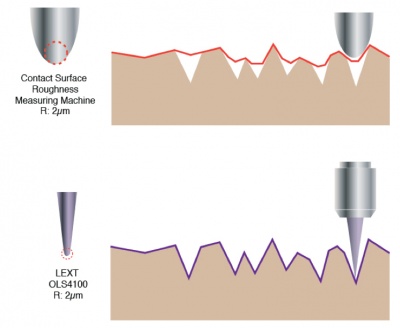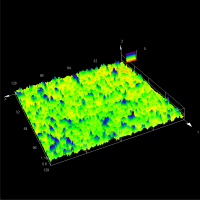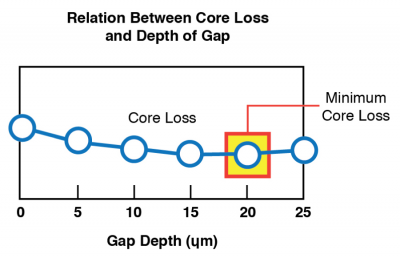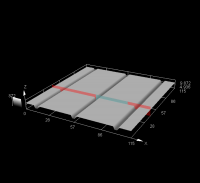There are many reasons to conduct steel plate surface texture topography analysis within a variety of industrial production environments. In automotive production, metallic or semi-metallic brake pads may need to be examined for friction wear, or the lubricity of steel engine shafts may need to be analyzed. In electrical steel production, grain orientation near the surface must be checked carefully in order to minimize core loss. This is critical to improving energy efficiency and signal performance in electric motors and transformers. The development of steel surface treatments and specialty surface coatings across a number of industries also depends on surface analysis for quality assurance.
Steel plate surface topography is complex and can vary greatly, with sample areas often measured in sub-micrometers. This type of area is hard to observe with a metallurgical microscope and quantitative surface depth analysis is not possible with a metallurgical microscope. Olympus’ LEXT® OLS4100 laser scanning digital microscope offers a more effective observation and analysis option when working with steel plate samples at high magnification.
Corrosion Analysis
In addition to steel plate samples that have undergone friction wear or conductivity in industrial environments, there is also often a need to measure the effects of weather and water or other liquids on steel samples. In these instances, the level of corrosion after either the combined cycle test method — the use of combined cycle test equipment to create controlled salt water, dry, or wet environments — or the outdoor exposure test method — where a steel sample is left outdoors with various other types of steel plates to be exposed to different natural environments — is analyzed at high magnification.
In order to accurately evaluate corrosion levels, the depth between the surface and the deepest point of corrosion is measured, with small corrosion measured at the sub-micrometer level. There are four basic types of corrosion found within steel plating:
 |
|
Four types of corrosion found in steel plates.
|
Small steel plate corrosion can be very difficult to observe and analyze using a metallurgical microscope. The OLS4100 laser scanning microscope provides all of the data needed to effectively measure and understand small and large corrosion samples across a variety of usage and exposure environments. The following are steel plate corrosion images made using the OLS4100 microscope:
 |
 |
|
Topographical features of small corrosions are visualized under higher magnification.
|
 |
 |
|
Large corrosion; image stitching is often necessary to understand the shape of a large corrosion pattern.
|
Sample Analysis: Steel Plate Roughness
When an automotive company needed its steel supplier to measure steel plate area roughness at a high resolution, the OLS4100 microscope delivered both higher resolution and the ability to accurately measure area roughness. The following represent steel plate roughness measurements taken using the OLS4100 microscope versus those taken with a contact surface roughness measuring machine:
 |
 |
Sample Analysis: Electrical Steel Surface Morphology
Electrical steel is steel that includes around 3% silicon to improve its magnetic characteristics. As electrical transformers use magnetic power to transfer voltage, electrical steel is widely used in the iron cores and coils in transformers to improve magnetic power. The quality of electrical steel directly affects energy savings and CO2 consumption.
 |
When a gap occurs within the surface of electrical steel, the magnetic characteristics of that steel are negatively affected. The larger the gap, the higher the amount of potential core loss. When analyzing core loss, it is necessary to accurately measure these small surface gaps to determine the gap depth's relation to core loss. The reduction of core loss is critical to higher energy efficiency and better signal performance.
To measure a 20 µm gap, the accuracy should be around 1–2 µm for reliable measurement. The OLS4100 microscope can measure these gaps with accuracy below 1 µm. In addition, an operator can capture a 3D image with the OLS4100 microscope within 30 seconds, reducing inspection time and freeing up time for other analyses.
 |
 |
Sample Analysis: Surface Treatment and Coating Development
New steel surface treatments and surface coatings are regularly developed as a way to improve corrosion stability, add special features to steel plating, and improve the appearance of steel components. During this development process, steel plate roughness is analyzed as it relates to the performance of these treatments and coatings. With the OLS4100 microscope, any number of treatment and coating components — including top coats, primary coats, chemical coats, alloys, and the steel plate itself — can be carefully observed and analyzed in relation to surface roughness.
 |
|
Steel plate roughness as it relates to the performance of surface treatment and coating.
|
Summary
Whether used to observe and analyze steel plate corrosion, friction wear, surface roughness, or core loss, the Olympus LEXT OLS4100 confocal laser scanning microscope delivers highly effective observation and analysis at the sub-micrometer level. Operators can capture high-resolution 3D images within 30 seconds, cutting down on individual user time and increasing overall inspection efficiency. Industries that present ideal environments for steel plate surface analysis using the OLS4100 microscope include automotive, power generation, surface treatment and coating development, aerospace, defense, and manufacturing.

